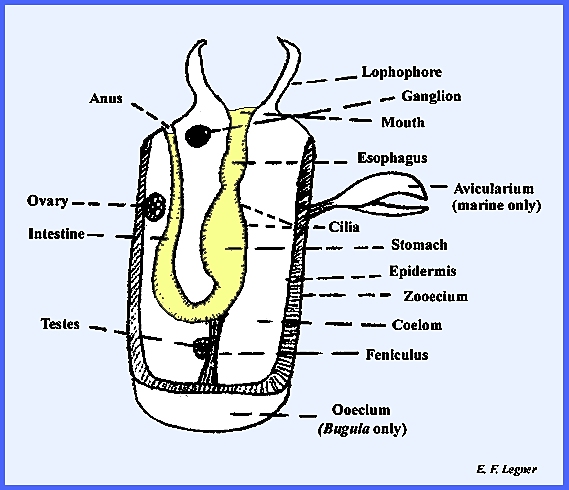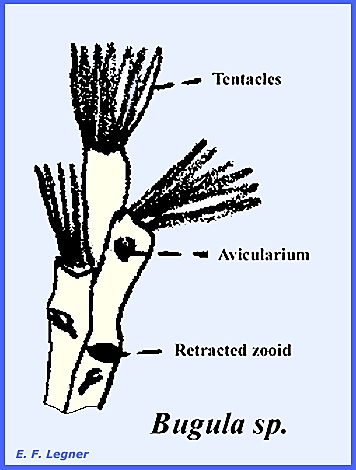File:
<bryozoa.htm> <Index to Invertebrates> <Bibliography> <Glossary> Site Description
<Navigate to Home>
|
Invertebrate
Zoology Kingdom: Animalia, Phylum: Bryozoa (Contact)
CLICK on underlined Plates to view and included illustration to
enlarge: Members of the phylum Bryozoa have been
referred to as "Moss Animals"
and "Ciliated Crowns." Two groups have been separated: The Ectoprocta are
those with the anus located on the outside of the lophophore and
the Endoprocta where the anus occurs
inside of the lophophore. The Endoprocta are no longer
generally recognized as a group, however. These organisms form low, crusting
mats over leaves, sticks, etc. in the water.
They occur in marine environments and in slow, sluggish freshwater
streams. Although individually
microscopic, they form macroscopic colonies. There are two body forms: Zooida
and Zooecium. Individuals of the Zooida resemble polyps
of Ctenophora or Cnidaria superficially.
They secrete a case around themselves, which is called the
zooecium. The zooecium is continuous
in the colony of some species and a large size may be assumed at times. This is composed of chitin-like material,
gelatin or calcium carbonate, all of which are proteinaceous in the marine
environment. In fresh water forms
this is always gelatinous. Characteristics of the Phylum Regarding Body
form, the whole upper portion of the body is
capable of being withdrawn into the zooecium. Then the exposed portion is called the introvert,
which is covered by an extremely thin case consisting of the same material as
the zooecium. Tentacles form around
the mouth in the form of either a complete ring or horseshoe shape (=
lophophore). The Body
Wall consists of a simple epidermis, which
secretes the zooecium. Thin layers of
circular and longitudinal muscles are well developed on the introvert
only. The peritoneum lines all the
interior portions of the coelom. A True
Coelom
is present, which is
the first case of this being found in the present organization of
Invertebrates. It is completely lined
with peritoneum and is formed of mesoderm.
The peritoneum also covers the digestive organs and all inner
portions. Food
and Digestion.-- Microscopic animals
are gathered by cilia on the tentacles.
These cilia not only force food down the gullet but also stir it up in
the gut. The mouth of the digestive tract
and the anus are positioned close to each other. There is a looped, U-shaped digestive tract. The entire gut is ciliated throughout. Circulation.-- There
is no circulatory system present, and food is move by fluid in the coelom. Respiration.--
There are no special respiratory organs.
Any exposed surface serves here, which is usually afforded by the
tentacles. Excretion.--
There are no excretory organs.
Excretion is accomplished by diffusion. Support
& Protection.-- The zooecium
provides both support and protection.
Some protection may also be afforded by the avicularium (see below).
Movement.-- There is no
locomotion. Well-developed retractor
muscles are present, which pull the introvert down into the zooecium. Muscle layers occur over the entire body. Avicularium.--
Also known as the "little bird," this structure is found only in
marine forms. It is a bird-like beak
that serves to ward off other animals or plants, which would settle-down and
grown on the organism. This serves to
keep the colony clean. It is believed
to be a highly modified zooid. Nervous
System.-- The simple nervous
system consists of a single nerve ganglion that is situated between the mouth
and the anus. There are no visible
sense organs, but the exposed body surface is highly sensitive to stimuli. Reproduction.--
Bryozoa are hermaphroditic. The Feniculus,
which holds the stomach in place, also bears the testes. The ovaries occur on the body wall. Self-fertilization may occur but is not
substantiated. Life
Cycle.-- In the Sexual Cycle,
the fertilized egg develops into a ciliated larva. In the genus Bugula,
the larva develops in an ooecium at the base of the zooecium. In Plumatella it develops
inside of the zooecium. The larva
breaks out through a temporary hole in the body wall. It then swims about for a few days and
settles down. Later it gives rise to
the whole new colony by asexual reproduction. In the Asexual
Cycle, freshwater Bryozoans
(e.g. Plumatella), bud to form statoblasts. These are produced on the feniculus similar
to the gemmules of the Porifera.
Statoblasts are covered with spines.
They remain in the interior of the body and carry the organism over
dry seasons when the parent disintegrates.
Asexual reproduction is much more common than sexual reproduction in
freshwater forms. Importance.-- Bryozoa are of no
economic importance but have great academic interest. The genera Plumatella,
Cristatella
and Pectinatella are widely
studied. Comparison of Marine
with Freshwater Varieties.-- The freshwater genus Plumatella
is a colonial organism, which has a common and continuous cavity throughout
the entire colony. Three is a
gelatinous zooecium
and the lophophore is horseshoe-shaped. Larvae develop at the base of the zooecium on the interior. There is no avicularium but statoblasts are present. The marine genus Bugula
is colonial. Individual bush like
cases are distinct and not in communication.
There is a chitinous zooecium and the
lophophore is a complete ring. Larvae
develop in the ooecium. There is an avicularium but no statoblasts are
present. ------------------------------------ Please see following
plates for Example Structures of the Bryozoa: Plate 34 = Phylum: Bryozoa: Plumatella sp. & Cristatella
mucedo Plate 35 = Phylum: Bryozoa -- Example Structures: Pectinatella sp. & Bugula sp. ============== |

